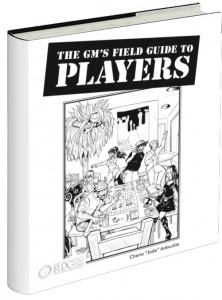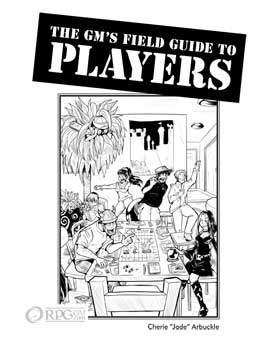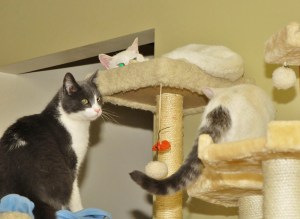 We love this hobby of ours so much, it’s only natural we’d want to spread the word. We do our damndest to get our non-gaming friends to give this “roleplaying thing” a try. This is especially true if we’re far from other gamers and the only way to get a group is to build one ourselves.
We love this hobby of ours so much, it’s only natural we’d want to spread the word. We do our damndest to get our non-gaming friends to give this “roleplaying thing” a try. This is especially true if we’re far from other gamers and the only way to get a group is to build one ourselves.
But how do you run a game for an entire group of brand-new players? Especially when you’ve been playing so long, you can’t remember what it feels like to be brand-new?
This is the first in a series of posts with ideas to help you introduce new players to our illustrious time sink …er, pastime.
When Your Whole Group is New
Do the planning for them
New players are often overwhelmed by the character sheet alone. Are we expected to know all those numbers? How do we actually use the stuff that’s on there? Give brand-new players pre-generated characters, especially when you’re teaching an entire group of first-time players.
By using pre-generated characters, you make a lot of overwhelming decisions for the players. They don’t have to worry about choosing effective skills, powers, spells or weapons, because you’ve already done that for them. Too many choices become intimidating. Even first-time players realize that some choices would be more effective than others, but which ones?
Limiting choices was part of the success of the original D&D game, IMHO. And I think it’s one of the reasons D&D was wildly more successful than Traveller, another early RPG. Traveller had (and still does) an open-ended character generation system. Sure, you chose a branch of service and rolled randomly for skills, but you still had to create a role in the party.
Being from the Navy didn’t give a new player any ideas on how to actually play his character. It was entirely up to you to define your place in the universe. Great for an experienced player with a strong character concept and goals. But if you’d never played an RPG before, you really didn’t know what kinds of things your character could do. If you’d never played Traveller before, you really didn’t know what kinds of things your character could do.
Original D&D took care of that for you. You had only four classes (well, really six—dwarf and elf were treated like classes), each with a very distinct role in the party. Fighters fought, magic-users cast spells, clerics healed and thieves disarmed traps and opened locks. Each class had a built-in purpose that made them very accessible to brand-new players and this worked really, really well new players.
Choose your game system carefully. When you’re introducing a group brand-new players who’ve never roleplayed at all (as opposed to experienced players learning a new system), you want something that’s simple, without being too simplistic. Pick D&D over Rolemaster, Star Wars over Traveller, and anything over Amber (unless your entire group are die-hard Zelazny fans).
This is not the time for you to run a system for the first time. Pick something you’re very familiar with, so you don’t waste valuable teaching (and playing) time looking things up. Plus, if you’re constantly having to look up things, you make the game seem much complicated than it actually is. When you use a system you’re very comfortable with, you give the impression “See, this isn’t so hard. I don’t even have to look up the rules, it’s that easy.” It makes the system much more accessible.
Limit choices, but make sure you give some
If you’ve ever had toddlers, you know how effective an empowering it is to let them choose something from a limited and predetermined set of options. Do you want to wear the green pants or the new skirt? The same goes for new players. Do you want to use a healing potion or have the cleric use her last spell?
Don’t be afraid to make suggestions during play. Most brand-new players will be grateful for the advice, especially if you explain the reason behind your suggestions. Just remember that the players are free to choose something other than what you suggested. That’s part of the learning experience.
Don’t make them feel stupid or wrong because they made an ineffective choices, just let the results of their actions catch up to them in-game. If one of their choices doesn’t work, explain afterwards why it didn’t work well and what might have worked better. Never imply it was a stupid or bad decision. Instead, use language like “less effective”.
Take it slow
Plan a short adventure. While you may consider a mission to stop an ogre from carrying off the nearby town’s livestock dull and routine, the players have never done it before. They’re not going to feel cheated because the “dungeon” is nothing more than a three-room abandoned farmhouse and the “treasure” is a masterwork (non-magical) sword and a single healing potion. And if your adventure doesn’t look like it will fill and entire game session, remember that you’ll be stopping frequently to answer questions and give explanations. It’s much better to end too soon than to go too long.
Give out information as the players need it
Don’t try to explain the entire character sheet at the beginning of the adventure. You’ll just confuse the players and they won’t remember the explanation, anyway. Instead, explain each section just before the players need to use it. Explain initiative as they’re getting ready for combat. Explain lock-picking when they encounter that first chest. Because they then immediately use that information, they’ll remember it better the next time they need to use it.
When you explain something, also explain why it’s done that way. Explain that you roll for initiative because you need to know in what order things will happen. Explain that you go around the table in initiative order because faster characters get to act first and because it helps you make sure you haven’t missed anyone. While this will help the players remember what to do next time, you’ll probably still need to remind them of the details the first several times they do something.
Follow their cue
Go through the adventure at they players’ pace. If they’re having trouble with combat, add in a few more easy fights. If they mastered skill use on the first go, make the next set of skill challengers a little bit harder. If they want to spend 40 minutes real-time looking for secret doors, let them, as long as everyone is having fun with it (and, if they look that hard, consider letting them find one, even if it just leads back to a room they’ve already explored). Be prepared to change things to fit the group even more than you would for an experienced group.
Make learning the goal
Don’t get hung up on finishing an adventure in the first game session. Your goal should be on teaching the game, not accomplishing the mission. If you’ve chosen a small enough adventure, this probably won’t come up. If it does, remind yourself that your real goal is to encourage these players to come back for more. Sure, the players will feel great if they save the day, but it’s much more important that they have fun.
————-
This post is a slightly expanded version of a post on the rpgGM.com homepage: Some Tips for Introducing New Players to RPGs. Next time we’ll cover adding a brand-new player to a group of experienced players.
[Image courtesy of tim_and_selena via Flickr Creative Commons]
























